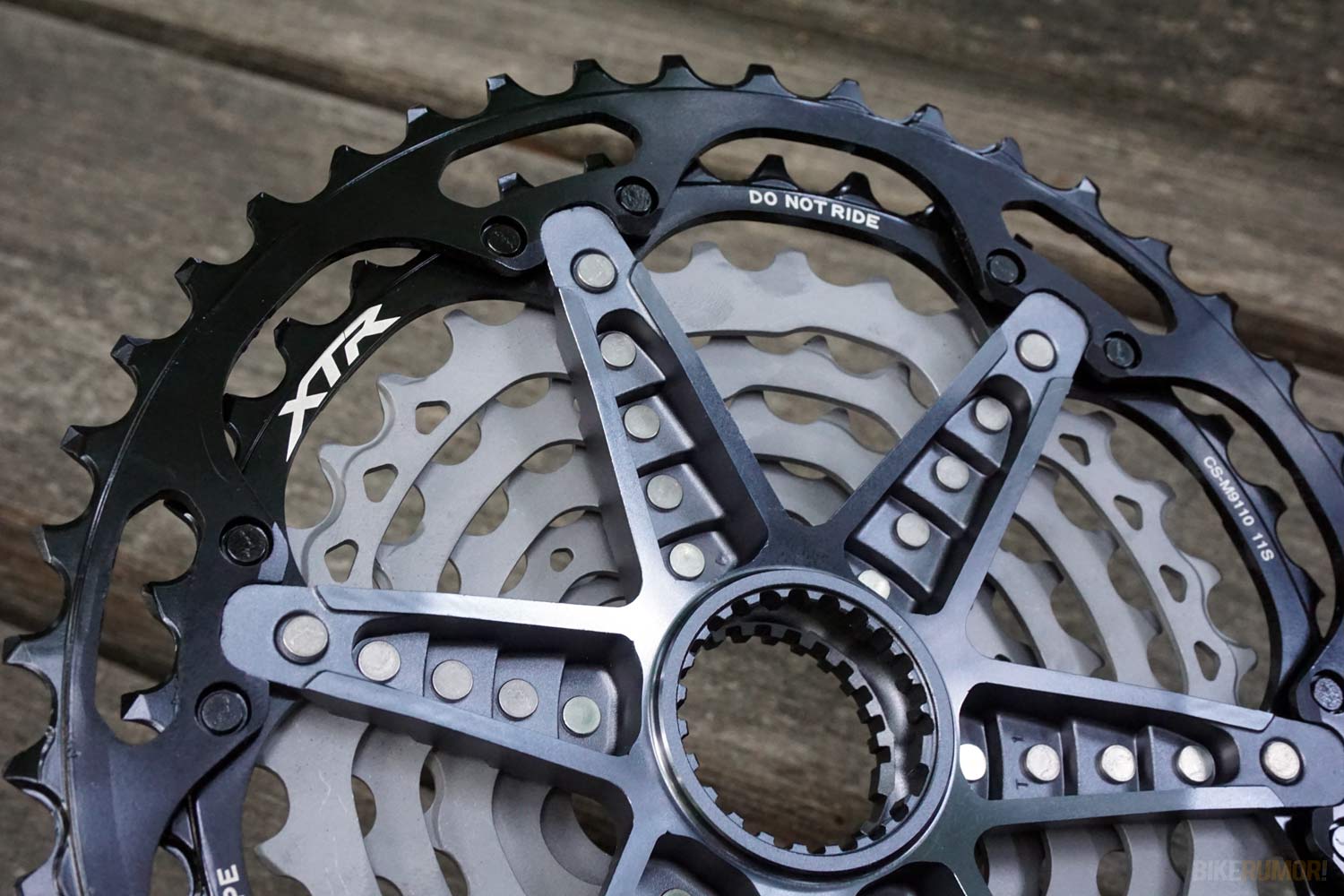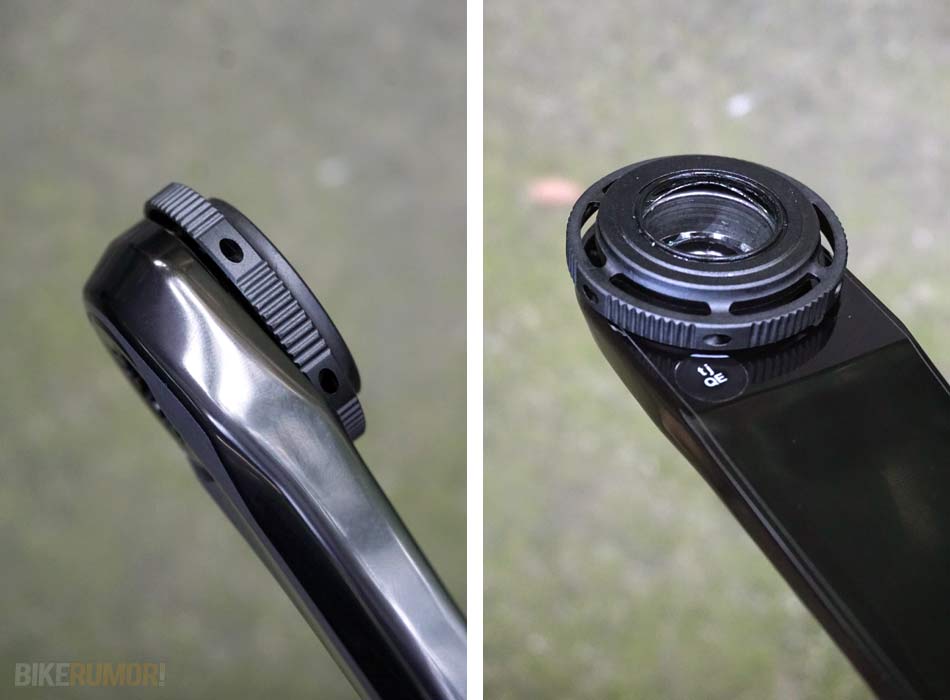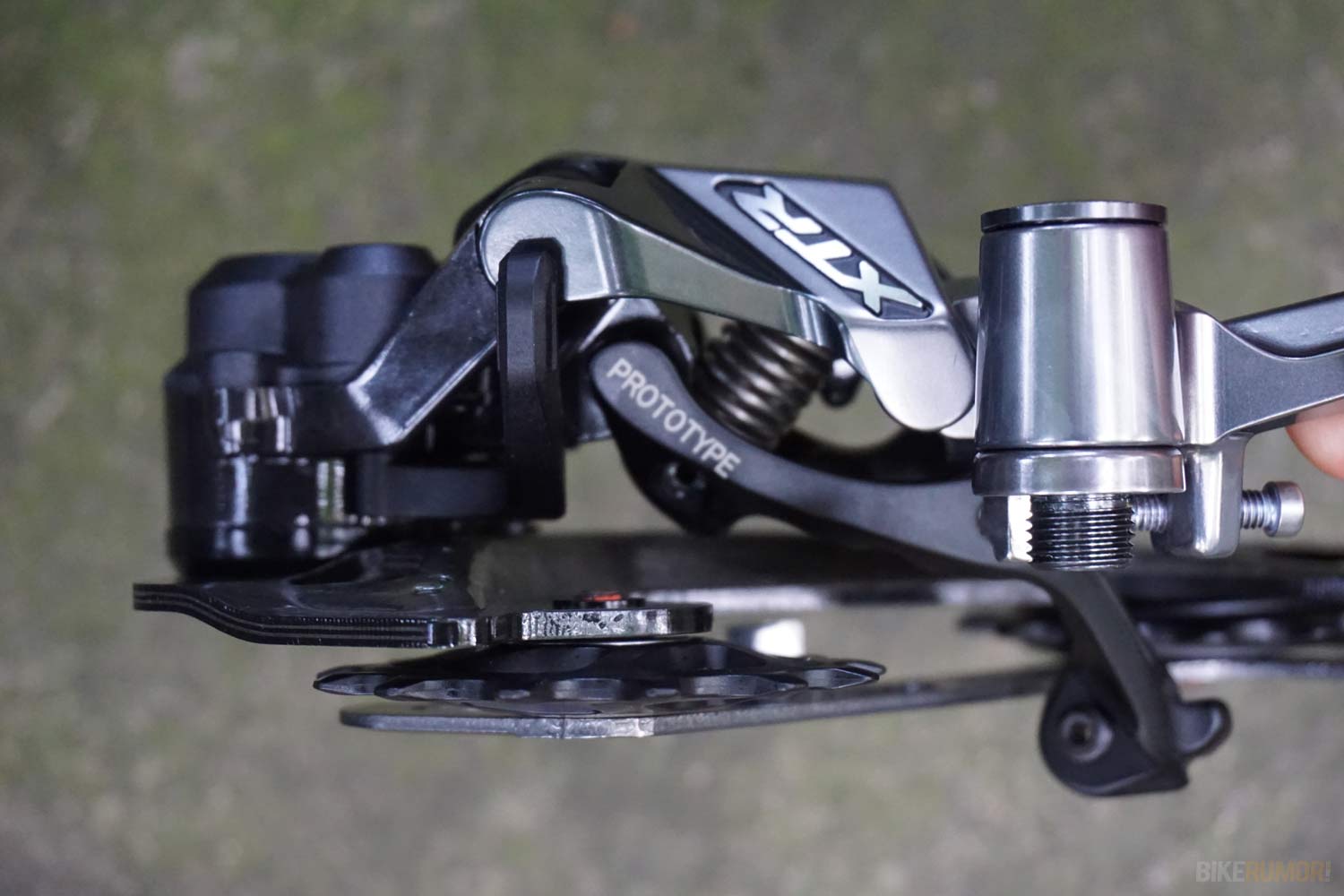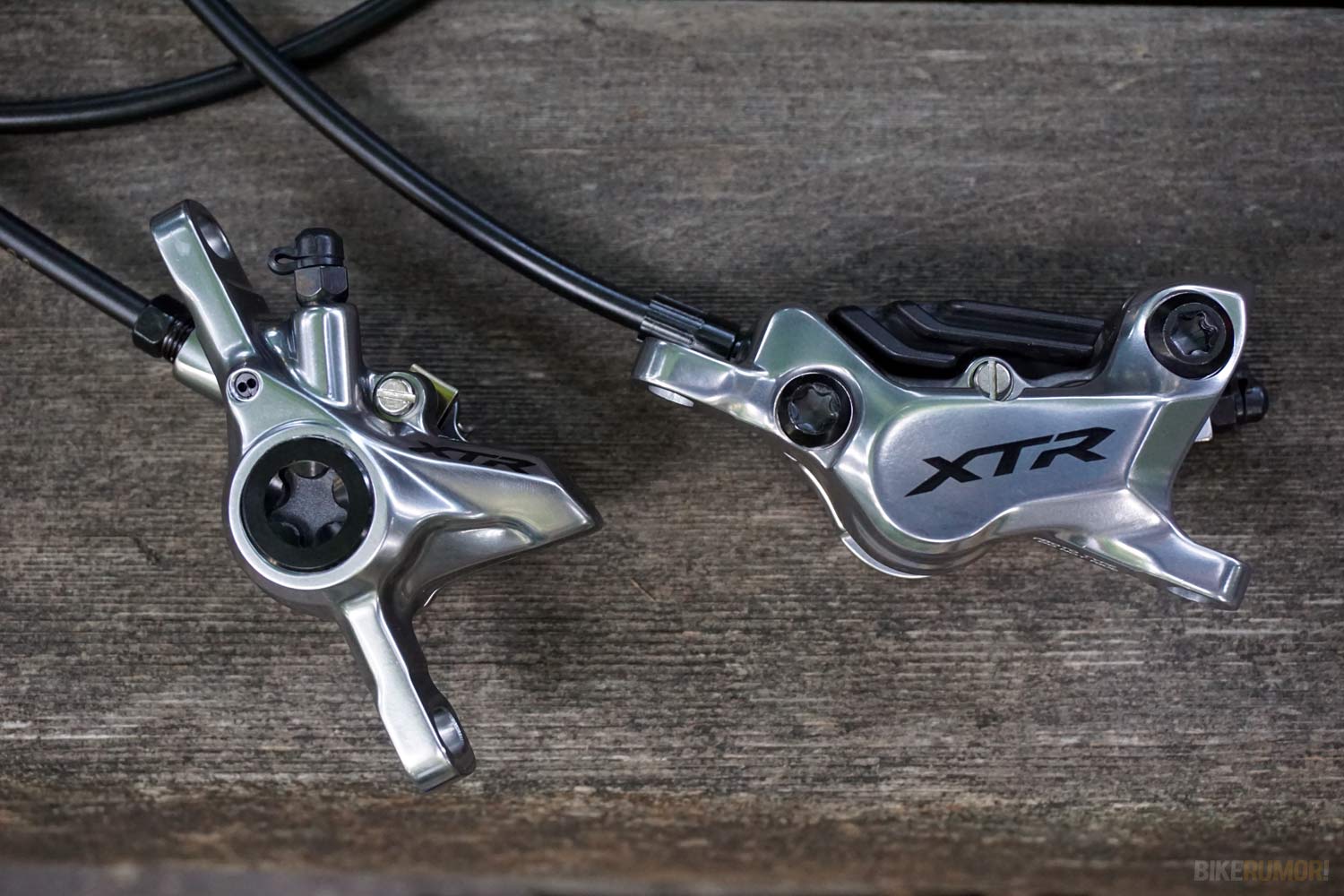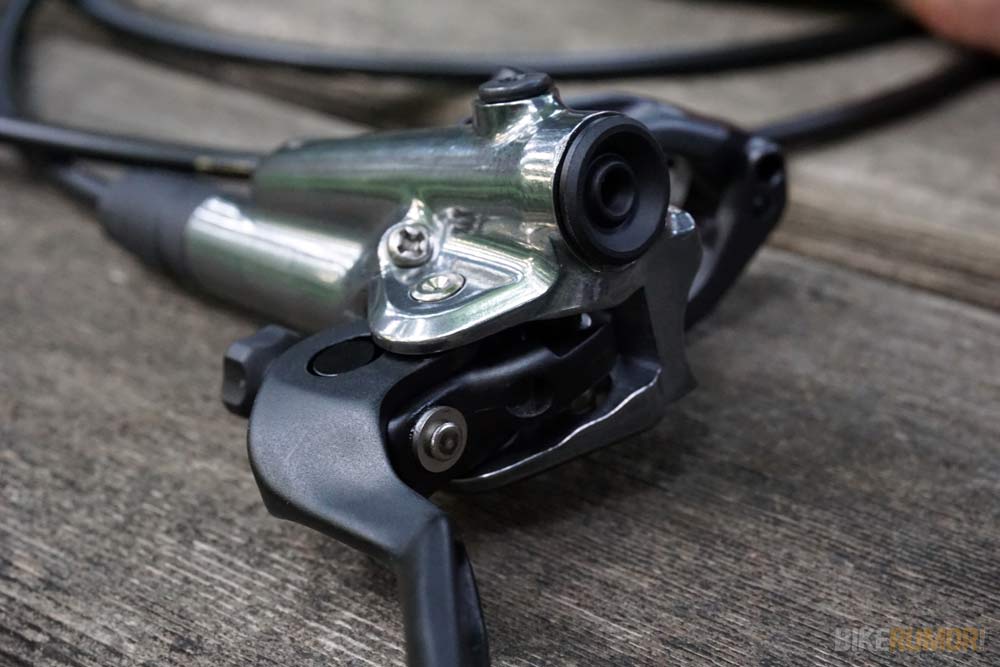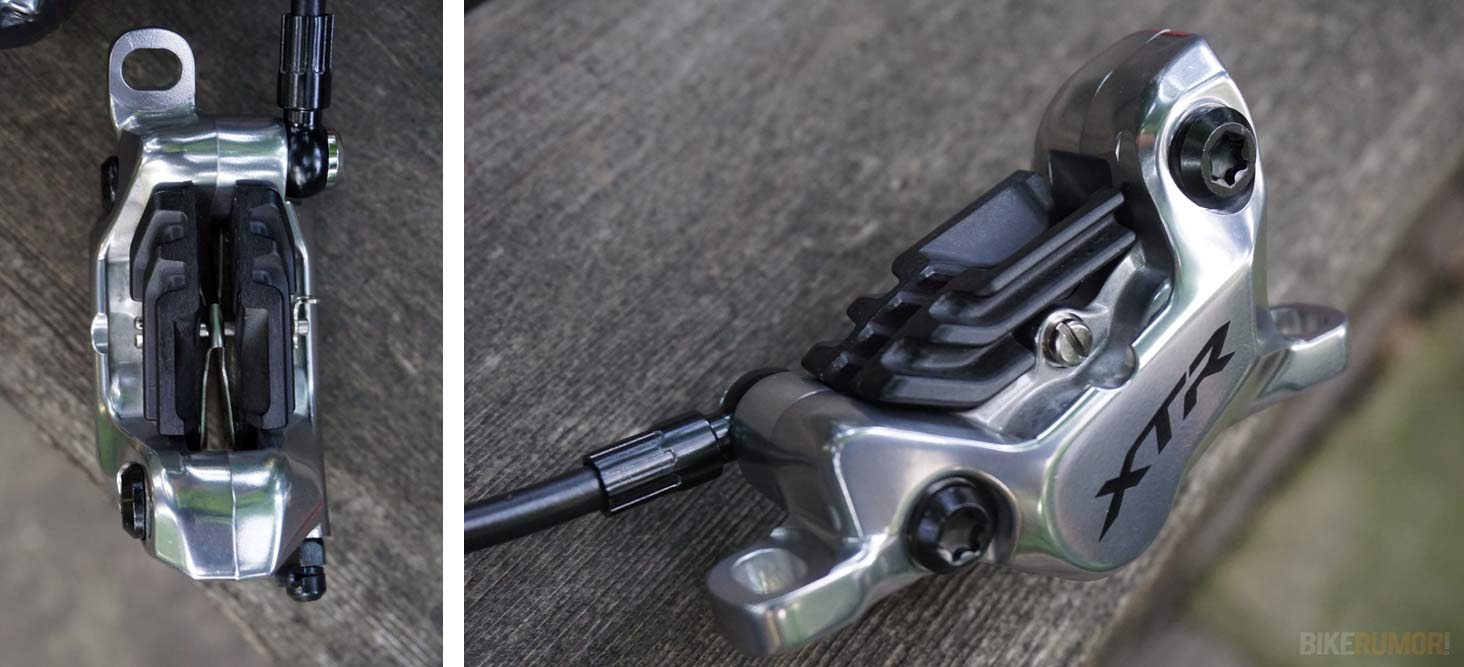Remember when the first XTR came out? It was XT with an R, for Race. That group was designed for racing, and it still is. If they have to make a decision about whether or not to add a feature, they’re going to err on the side of being for the racer. With 2011’s M985 XTR, they split into Race and Trail editions, which carried through 2014’s M9000 group. Now, with the explosion of enduro, it’s all about racing and making the bike go as fast as possible, regardless of how you ride.
Getting more speed can come from many places. Faster shifts, reduced friction, more predictable controls, and performance that lives up to expectations at every corner of the bike.
This meant the controls needed to be intuitive, but also ergonomic. A lot of attention was paid to how it fit into your cockpit, keeping everything within reach so that you can keep a solid grip on the bar, even while shifting. Or dropping your seat post.
Requirements for a modern mountain bike were 1x chainrings up front, wide range cassettes in the back. Those were the minimums, but that was only the start. Some design features were mandated by the need to shift across a massive cassette. Others were new ideas that they only recently developed the manufacturing capabilities to execute on.
We have all of the tech details, but first:
- Yes, it’s 12 speed. And 11 speed.
- Yes, it has wider range than SRAM Eagle. Or not.
- Yes, they had to redesign the freehub body.
- And yes, they now have direct mount rings.
Here’s how (and why) they did it…
XTR M9100 Cassette & HYPERGLIDE+
At the heart of the new group’s improved performance are the cassette, chain, and cranks. Together, they are largely responsible for what Shimano is calling a total revolution in drivetrain performance.
In 1976, Shimano debuted Uniglide, simply angling some of the otherwise flat stamped teeth. By 1988, Hyperglide came along with CAD shift ramps so the chain could engage the next larger cog before it’s fully left the cog it’s on. Hyperglide only works moving from a smaller cog to a larger cog. Which is why you get smooth shifts going up to a larger cog, but you hear that clunk-clunk-clunk as you go down-down-down.

Until now. For MY2019, XTR M91000 introduces Hyperglide+ to finally offer Hyperglide shifting in both directions. No more chunky drops under hard accelerations. What’s the benefit? Shock-free shifting that’s 1/3 faster. For racers, that’s fractions of a second per shift during a finish line sprint, without the abrupt clunk-clunk-clunks that can disrupt your cadence. And you can keep pedaling throughout the shift without needing to ease up.
Beam Spider construction holds the top eight cogs, of which the middle 5 are titanium, and the top three are aluminum with a tough surface treatment making them more durable. The lower cluster has four steel cogs. Add that up and yes, you get 12 speeds.
The gear options they came out with are based on racer feedback. Specifically, professional EWS racers’ feedback. Shimano asked racers whether they wanted the widest possible range, or improved gear steps. The initial response was 64% for range, and 36% for ideal steps. Once they drilled down and asked more specific questions, it turned out that about a third of the racers said an 11-46 or 10-45 offered all the range they needed. Why? Because depending on the course, some racers simply sized their 1x chainring up or down, which when paired with a tighter range cassette, gave them smoother transitions without really losing much range.
Ask XC racers the same thing and they voted 68% to 32% in favor of the widest range. Which makes sense because they want a high top end for sprints, and a low gear so they don’t blow out their legs on the climbs. Still, Shimano says just over 1/3 ended up saying the 11-46 or 10-45 options were enough. Which means not everyone really wanted the now common 500% range. The point is that not everyone wants or needs the same thing, so they’ll have options:
- 10-51 12-speed Wide Range
- 10-45 12-speed Rhythm Step
- 10-45 11-speed lightweight spec
The latter is the same as the Wide Range 12-speed cassette, except with the 51-tooth cog removed. The spider is built the same at its base, though, so you won’t need any spacers or anything to put the 11-speed cassette on your 12-speed hub. Each one is a dedicated cassette, you can’t just throw the 51-tooth back on there for easy days. Cog spacing is the same on all of them, and the new 12-speed shifters will work with all three options.
How much lighter is the 11-speed setup? Shimano says it’s 57g for the 51-tooth cog, and the chain can be 6 links shorter (~20g savings), and you can run a shorter cage derailleur to save another 3g. So, about 80g savings. Other benefits of running the cassettes with the smaller top cog means you can run the shorter RD cage, which provides less chain slap, better chain retention and better ground clearance.
And that 51-tooth cog, is it there just to outdo SRAM? No, they say it’s about maintaining the right rhythm of gear steps, but it certainly doesn’t hurt.
2019 XTR HG+ Chain
The HG+ chain is designed specifically to work with the new chainrings, and officially it will work only on Shimano chainrings. Why? Because it uses a new “Dynamic Chain Engagement+” design. Because the DCE+ tooth profiles are new, this new chain won’t fit properly onto older Shimano chainrings, and they caution that it likely won’t settle down far enough for proper engagement on other third party chainrings, either (before you freak out, keep reading).

With narrow-wide chainrings now standard equipment, Shimano saw room for improvement in the way the chain engaged with those alternating tooth profiles. The interface between the chain and the chainring is different on narrow teeth and wide teeth. The chain’s inner link plates are extended to improve their fit around the wide teeth, which reduces vibrations.
Now, because the majority of the contact between the chain and the teeth is happening on the inner link plates, the wider space between the outer links isn’t fully utilized. In effect, the chain’s interior is narrower, so the chainline is held more tightly in the center. Not only do they say this helps keep everything feeling smoother, but it also reduces drivetrain noise by 4db.

Most of this shaping work is meant to improve the interface with the chainring, but it also plays a small role in Hyperglide+ performance. As such, it is a directional chain, the logos need to be facing outward.
Chromizing surface treatment is used on the inner link plates and pins to make it tougher while still offering the friction reduction properties of the Sil-Tec coating they’ve been using (and that will still be used on the outer link plates). Chain is a bit narrower, but tested durability is the same as the M9000 group’s chain thanks to the Chromizing process, and spacing between cogs is bit narrower, too. They didn’t have official width numbers at the launch event, but we’ll update if they provide them.
XTR M9000 Cranksets & Chainrings
Yes, they have finally moved to Direct Mount chainrings. And thanks to the new HG+ chain design, they say they can run a 52mm chainline on all bikes, Boost or not (52mm is a standard Boost spacing). The arms themselves are a refinement of previous models that are a bit lighter and stiffer, and they’ll come in two Q-Factor options (162mm and 168mm). They’re not designated specifically as Race or Trail any more, but expect to find the wider Q-Factor (M9120-1) on more enduro-ish bikes, and the narrower one on XC and Marathon bikes.
Look for 30/32/34/36/38 tooth count options on the 1x chainrings. Doubles are still available, only in a 38/28 combo, using a direct mount large ring with a bolt-on small ring. This means you can easily swap between single and double setups if you want, however it will only work with the 10-45 cassettes.
So, why would you want a double? Here’s how it breaks down:
- 2x: 28/45 (0.622) on the double is similar to 30/51 (0.589) single for easy spinning.
- 2x: 38/10 (3.800) is the other extreme for downhill hammering, and this can be replicated with a 1x setup.
- 1x: 30/51 (0.589) gets you close to the same easy gear as the double.
- 1x: 38/51 (0.740) is the easiest you’ll get with the biggest 1x chainring.
- 1x: 32/10 (3.200) provides a good middle ground for most riders and saves a lot of weight.
It all adds up to a little more than 600% range out of the 2x, where the max is a 510% range from the 1x. Which is the equivalent of getting about two extra shifts at one end of the cassette. Who needs this? Multi day epic racers that want as many options as possible when they’re riding themselves into the pain cave day in and day out. Or bike packers. Or whoever, because you can spend your money however you want. Don’t judge. That said, 100% of OE spec coming to North America is 10-51 12-speed 1x.
The chainrings use a lock ring that uses a standard Shimano BB tool interface, however it’s very thin. So, they’ll offer a tool slides over the 24mm spindle, aligning it perfectly with the lock ring, so even though the ring is thin, the interface is tight and secure. Yes, they’re sticking with the 24mm spindle, no 30mm spindle options are coming.
Gone is the pinch bolt design with that plastic preload bolt. Now, it bolts onto the spindle the same way Race Face, FSA, SRAM, etc. cranks do. A new preload ring is finger adjustable, with holes to stick an allen key in for extra leverage.
Now, about that proprietary chain/chainring interface: We’ve heard Pivot will be offering the group on the new Mach 429 Trail, which is a Super Boost bike that needs a wider chainline. Shimano isn’t offering a crankset or chainring with that chainline, so they’re spec’ing Race Face 1x chainring flipped to adjust the chainline outward. Chris Cocalis isn’t one to compromise performance, so our hunch is this is a solution for bikes needing an alternate chainline.
XTR M9100 Rear Hub & Scylence Freehub
There’s a LOT going on with the new XTR M9100 rear hub. First, the new Micro Spline freehub body is their solution to fitting a 10-tooth cog. Why not use the XD Driver Body? Two reasons. Functionally, XD requires a one-piece cassette, which isn’t something Shimano is going to do. And, let’s be real, because XD is SRAM’s design.
They’ll come in straight pull and standard flange options, in 28 and 32 hole counts. They say the straight pull design is within a gram of a DT Swiss 240 hubset.
The scallops on the driveside flange are there to save weight, but also to help the non-drive spokes clear it when pushing them through to build your wheel. There will also be a Wide Flange hub option made specifically for the 11-speed cassette that pushes the driveside flange out 4.7mm more than normal, taking up the space where that 51-tooth cog would have been. Basically it’s Boost hub spacing with Super Boost wheel stiffness thanks to more balanced spoke tension from side to side – but without room for the 12th cog.
With the need to truncate the freehub shell’s width to fit the 10-tooth cog hanging off the end, they had the opportunity for a clean slate. Micro Drive is the result, and refers to the smaller and more numerous splines. The new design allows them to use aluminum without fear of it being gouged by the cassette, which saves weight.
Inside the hub is their all-new Scylence drive mechanism. We knew this was coming when we found patent drawings a couple years ago, and all of our predictions have proved true. The Scylence works like this: When pedaling, the angled slots on the freehub shell (blue) pull the two yellow ratchet ring into the green one, which is fixed into the hub shell. Opposing teeth on the two ratchet rings engage, and your pedaling efforts drive the wheel forward.
When you’re coasting The spring behind the yellow ratchet pulls it back, away from the green one, so there is virtually no contact between them. This means virtually no friction, and virtually no noise. In fact, they’re claiming a whopping 40db decrease in hub noise. Meaning you can hear your tires on the ground, upping your Spidey sense for traction.
Because the “engagement” comes from the splines rather than pawls and teeth, it measures at an effective 7.6º engagement, but there’s 360º of actual engagement when the two rings come together. They say the driving force is 30% more rigid than standard systems, and it’s strong enough for e-bike use, so expect it to show up there in the future.
Scylence is only for the new XTR drivetrain for this year, but will also be available on the non-series MT900 hubs, too, for more price conscious OEM builds. These don’t get the same weight saving measures or high polish finish, and will come in 28-hole, Boost spacing only, where XTR hubs will have both standard and Boost options.
Will XTR M91000 work with 3rd Party hubs?
Yes, but it’ll be limited at first. DT Swiss was a development partner, in a sense. Shimano worked with them to ensure the Micro Spline shape could work on DT’s modular hub design in terms of freehub body length and inside diameters clearing various axle options and end caps. Plus, admittedly, Shimano’s mountain bike hubs and wheels sales are much lower than DT’s. So they needed some popular aftermarket wheels to be available to help spread adoption and OE spec of the new XTR group. At launch, you should be able to find DT Swiss hubs with Micro Spline or order a Micro Spline freehub body to swap onto your existing wheels. Supposedly, DT Swiss will have a Micro Spline Super Boost Plus hub soon that will allow Pivot and other bikes to run the new XTR group.
Why no more XTR mountain bike wheels?
Shimano is focusing on their strengths, which is hubs, not rims. So they’re offering their hubs for OEM spec to be laced to other rims. DT Swiss is also a licensed partner, so they’ll also have Micro Spline compatible hubs that have DT’s modular construction. So you’ll see wheels on bikes spec’d with this new XTR coming with either DT or Shimano hubs, but they could be laced to any number of rims. Already have a nice set of wheels with DT Swiss hubs? No worries, the Micro Spline FH body can be retrofitted to existing DT hubs.
XTR M9100 Derailleurs
Yes, plural. They’ll still offer a front derailleur to work with that double chainring setup. But the real news is on the rear derailleur. The parallelogram and movement is all new, required to work across the massive range of the 10-51 cassette. They say it’s quieter, aids chain retention, and improves drive efficiency by reducing the chain tension when in the bigger cogs. That should mean faster, smoother shifting feel at the lever. Two versions are offered:
- GS Type – 45T max cog size, but has 28mm better ground clearance
- SGS Type – 51 max cog size, can also worth with the 10-45 cassettes
The shorter cage doesn’t really save that much weight, but it does reduce chain movement because it’s reducing the lever arm length that the chain has to work with. 13-tooth pulley wheels add a bit more chain wrap, which helps them keep the cage a little shorter on both versions. There’s also a M9120 SGS RD with revised parallelogram and pulley wheel placements that’s made for the 2x drivetrain and has a max 45-tooth limit. As such, it will always get paired with the 10-45 12-speed cassette.
On the bottom is a convenient clutch tension adjustment port, covered with a rubber seal. Just reach your allen wrench in there and customize the tension to your liking.
The front derailleur will come in D, E, and M mounts, all using the SideSwing routing. They can adapt between 48.8mm and 51.8mm chain lines to work with Boost and non-Boost bikes.
Shimano XTR CD800 Chain Guide
Technically, the new Shimano chain guide is not an XTR part, but it’s color matched and is as clever as anything else in the group. Offered, in D (high), E (low), and ISCG05 mounts, one bolt handles height and chainline adjustments. When loose, slide it up or down, and a bezel on the back can be turned to adjust chainline. Tighten the single bolt and it locks both movements into position.
XTR M9100 Shifter Levers & Dropper Remote
To make you faster, they wanted the shifters to offer quicker lever access with more room to move your thumb between the two levers. The layout redesign claimed to offer 20% quicker lever access time, and new internals require 35% less force to shift (versus M9000) thanks to updated cable pull ratio and spring tension at the derailleur.
It can shift up to four gears in a single push, but the indents are more pronounced. The first click is lighter than the second, though, so it’s easy to get just a single shift without accidentally over shifting. The silver setting screw on the bottom of the rear shifter adjusts between 11- and 12-speed shifting, letting it work with any of the cassette options.
For the 2x, there’s a new Mono Lever that requires only a single lever (on the left side of the bar). Push it once to shift to the big ring, then push it again to release and have it drop down to the small ring. Simple, but what’s even more ingenious is that it can also be used on the new Fox “push to unlock” suspension parts as a fork or shock remote.
Both front and rear shifters will come with a standard round bar clamp or the new I-SpecEV. Sorry, it’s not backward compatible with regular I-Spec, because the position on the bar is different to accommodate the new brake lever design (keep reading). But, you can run the new brakes with older shifters if you use Clamp-on shifters instead of I-Spec.
What’s equally ingenious is their new dropper post remote that mimics Shimano’s shift lever, but not the one you’d expect. Where most every dropper remote replaces the position and feel of the main thumb paddle, Shimano decided to place it where the release lever is, so you don’t have to pull your thumb back as far to use it. It’s far more ergonomic. It has 7mm of cable pull and clamps the cable at the lever so it should work with most any mechanical dropper
XTR M9100 Disc Brakes
Functionally, the new master cylinder is much the same. But it has a new brake lever structure that rests the end of the master cylinder body against the handlebar. That, combined with a wider clamp band, creates a much stiffer, more direct lever feel. The clamp is much farther inboard, too, making room for different remote levers or even a small bell (we’ll have on-the-bike pics coming in a separate post).
The 2-piston Race Brakes are 26g lighter than the M9000 system. It uses a magnesium lever body and carbon blade, but with an aluminum caliper, so it’s stiffer. They say magnesium’s stiffness can change with temperature, so this new one should have more predictable performance.
It also gets a new inline hose fitting rather than a banjo, saving a few grams, and it sits inboard. The brake pad is slightly smaller, using the road flat mount brake pad, to save just a couple extra grams. But it won’t fit the finned pads because those won’t clear the bleed port.
Brakes ship with either resin or metal pads, depending on what the OE specs for their bikes, or what you order. In North America, Shimano USA mainly stocks metal finned (when available) pads for MTB and resin for road. And that choice of pad can affect retail price up to $20 per wheel.
The new 4-piston Enduro Brakes offer higher power, quicker brake engagement with shorter free stroke. They stick with a banjo connection, but also move the routing to the inside of the caliper. It gets an alloy lever and caliper. The lever uses their Servo Wave tech with a tool-free reach adjustment.
It gets a new finned brake pad, which will be compatible with all of their other 4-piston brakes. This one looks a little sleeker, and it gets tighter tolerances between the caliper body for less rattle. The fins look small, but they say they cool just as well as the other designs.
New rotors will come in 140/160/180/203 diameters and have one design for both “race” and “enduro”, but they have size specific designs that cater to the likely use. Smaller rotors that are typically used for XC get lighter, and bigger rotors for enduro get better cooling. The carrier is lighter than before, and they’ll be Centerlock only. They also get the heat dissipating paint from the Dura-Ace rotors.
XTR M9100 Pedals
The new PD-M9100 XC pedal is wider edge to edge for better stability, and it has improved mud shedding. Like the two Q-Factor options on the cranks, you have width options here, too. Look for 52 and 55 mm axles to help you fine tune your fit.
For XC racers, the short spindle option allows them to bring their Q-Factor back down a bit now that the cranks use a wider Q-factor.
The PD-M9120 Trail Pedal gets even wider than XC plus and adds the platform’s extra length.
New 12-speed Chain Tools
With all of these changes, Shimano recommends a narrower chain tool (TL-CN35 or TL-CN29) and a new chain whip that handles the slightly narrower cog spacing better. A direct-mount chainring lock ring tool will with the cranks for at least the first year, but it’s the same interface as their BB tool… it’s just that you might have a hard time getting a standard BB wrench into the backside of the spider.
Stay tuned for on-the-bike photos, weights, pricing and more in a separate post!



